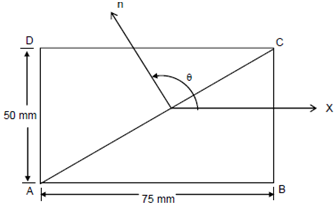Find the normal stress:
Figure 1 shows the projection of a rectangular prism ABCD, formed by adhesive bonding of two triangular prisms ABC and ACD. The state of stress in the prism is given by the components σx = 40 N/mm2, σy = 0 and τ = 0.
If the shear and tensile strengths of the adhesive are 10 N/mm2 and 12 N/mm2, verify the safety of the joints and find out the value of σx at which the joint will fail.
Solution
The aspect angle θ of the bonding plane AC
= 90o + tan-1 (50/75) = 90o = 33.69o = 123.69o

Figure
Known stress components are as follows:
σx = 40 N/mm2, σy = 0 and τxy = 0
Stress components on plane AC,
Normal stress, σn = σx cos2 θ
= 40 cos2 123.69o
= 12.3076 N/mm2 > 10 N/mm2
Shear stress τnt +-σx/2 sin 2θ
= - 40/2 sin (2 × 123.69o)
= 18.4615 N/mm2 > 12 N/mm2
The tensile stress on plane AC is not inside the tensile strength of the bond. Also, the shear stress on the plane exceeds the shear strength of the bond and hence, the bond will fail both in tensile and shear.
Let us find the normal stress σx that might be safely applied. Shear strength of the bond = 12 N/mm2
Shear stress on bonding plane -σx/2 sin 2θ
∴ 12 = - σx/2 sin 247.38o
σx = 12 ×2 /sin 247.38o = 26 N/mm2
So the maximum stress we may apply on the plane CB is 26 N/mm2. Here, you may note that in strength analysis the sign of the shear stress has no significance, while the sign of the normal stress is important, since the tensile and compressive strengths may differ considerably.